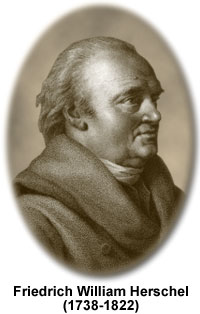Friedrich William Herschel
(1738-1822)

Friedrich Wilhelm Herschel was born on November 15th, 1738 in Hannover, Germany. His father was a military musician and each of his five children was taught to play a musical instrument. From 1753 until 1773, Herschel's career was that of a musician, and he belonged to a military music orchestra, was a church organist, and taught students music from his home. In 1773 his interest in astronomy suddenly grew and he read books on astronomy and bought instruments and lenses. Herschel's first telescope was a small reflecting telescope that did not satisfy him for long, so he decided to make a bigger instrument. Good mirrors and lenses were too expensive, so Herschel bought equipment from a man in Bath for pouring metal for the mirrors, and tools for grinding and polishing the mirrors so that he could construct more powerful reflecting telescopes. William's sister Caroline lived with him and assisted him in making his mirrors.
In 1779 while living in Bath, he was asked to join the Royal Society. Between 1779 and 1781 he measured the heights of about one hundred mountains on the moon, carefully recorded the data and prepared papers that were presented to the Royal Society.
On the evening of March 13th, 1781 Herschel discovered a bright object in an area of the sky where there was supposed to be no star. He suspected that it was a comet, and further observations revealed a slowly moving object. After additional studies and calculations it was determined that a new planet was formed. Herschel named the newly discovered planet Georgium sidus, or George's star after King George III. Later the name Uranus was proposed by Galle in Berlin and was used by most astronomers.
In November 1781, Herschel went to London and received the Copley medal from Sir Joseph Banks of the Royal Society. At the end of May 1782, Herschel was invited to London by King George III. He showed the royal family several planets during June and July and was offered the position of court astronomer at Windsor. His travels and experimental work was not covered by the salary he received for being the Royal astronomer, so Herschel began to build and sell telescopes. The high quality of his optics was soon widely known outside of England and he received many orders from foreign countries.
Between 1786 and 1802, Herschel published three catalogues containing data on 2500 heavenly objects. These observations were conducted with a telescope he constructed, which had a focal length of 20 feet and a diameter of 18.8 inches. It was with this telescope that he discovered the Uranus moons of Titania and Oberon. He later built another telescope with a 40-foot focal length, and a diameter of 48 inches. It was not his favorite, because the mirror needed re-polishing very often and the tube was heavy and difficult to handle. However with this telescope Herschel did discover the sixth and seventh moons of Saturn, Enceladus and Mimas. Herschel continued making observations and cataloging his discoveries until his death in 1822 at age 84.
